U.S. Department of Energy.
The U.S. Department of Energy said on December 13, 2022, that for the first time – and after several decades of trying – scientists have managed to get more energy out of the process than they had to put in.
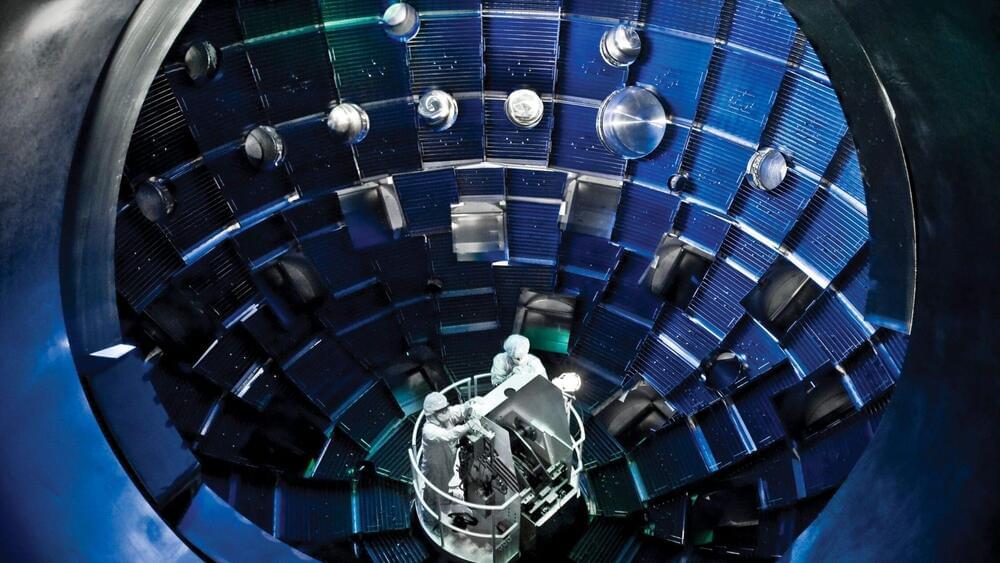

After six decades we have finally reached controlled fusion “ignition.” Here is how it works and what it means (and doesn’t mean):
At the Lawrence Livermore National Lab (LLNL) the National Ignition Facility (NIF) starts with the Injection Laser System (ILS), a ytterbium-doped optical fiber laser (Master Oscillator) that produces a single very lower power, 1,053 nanometer (Infrared Light) beam. This single beam is split into 48 Pre-Amplifiers Modules (PAMs) that create four beams each (192 total). Each PAM conducts a two-stage amplification process via xenon flash lamps.
Surpassing energy breakeven at US facility constitutes a “Wright brothers moment” for fusion research, say researchers.
Scientists have been striving to achieve fusion ignition for decades.
Scientists from the Lawrence Livermore National Laboratory (LLNL) announced a major breakthrough for nuclear fusion on Tuesday, December 13. In a historic first, they achieved fusion ignition during a nuclear fusion experiment. This means they produced more energy than they put into their fusion experiment, paving the way for practically limitless clean energy production from nuclear fusion.
Here’s why that achievement was described as a “history-making” moment by US Secretary of Energy Jennifer Granholm during the announcement event.
LLNL
In a historic first, they achieved fusion ignition during a nuclear fusion experiment. This means they produced more energy than they put into their fusion experiment, paving the way for practically limitless clean energy production from nuclear fusion.

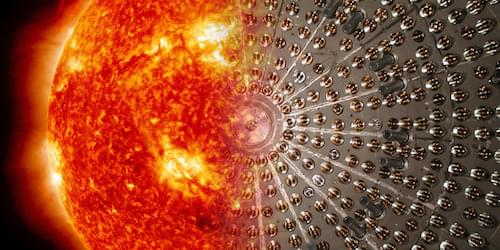
Measurements of solar neutrinos proved that our star is powered by nuclear reactions and has brought to light many other details about the Sun’s inner workings. They also led to the discovery of neutrino oscillations—a phenomenon that is difficult to reconcile with established theories. Current neutrino research mostly relies on neutrinos generated on Earth by reactors and accelerators. But some physicists argue that there is still a lot to be done with neutrinos generated in the Sun. A new generation of solar-neutrino experiments may help in solving outstanding questions about both neutrinos and solar physics, these scientists say.
The study of solar neutrinos began in the late 1960s. Using a detector filled with dry-cleaning fluid and placed in South Dakota’s Homestake gold mine, physicist Raymond Davis and his colleagues observed the first neutrino signal from the Sun. They were surprised, however, to find that the number of neutrinos was one third of what models predicted—a mystery that led to a “neutrino gold rush,” with many new experiments staking claims to different energy and length scales related to the neutrino behavior. Eventually, physicists explained the missing neutrinos as resulting from oscillations between neutrino flavors (see Nobel Focus: Neutrino and X-ray Vision). These oscillations implied that neutrinos have mass, in tension with the standard model of particle physics.
The study of neutrino oscillations continues with efforts to pin down the neutrino masses and mixing parameters that determine the oscillating behavior. The main target, however, is no longer solar neutrinos. “The majority of the community, by a large margin, is focused on accelerator neutrinos,” says Michael Smy from the University of California, Irvine. The reason for this shift, he says, is that an accelerator experiment can explore higher-energy neutrinos and control the source-detector distance over which oscillations may occur. Researchers can also switch the accelerator on and off, which helps remove certain backgrounds.
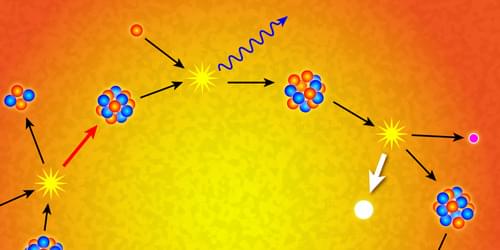
A study of neutrinos from the Sun has measured the signal from the so-called CNO cycle, offering a direct measure of the elemental abundances in the Sun’s core.
Solar neutrinos are copiously produced by hydrogen fusion reactions in the Sun’s core. Therefore, they are the direct evidence that the Sun is powered by nuclear reactions. Measurements of solar neutrinos have provided information about the temperature and density of the solar interior, but uncertainties remain about the chemical ingredients. Now the Borexino Collaboration reports a new measurement of the neutrino flux produced by the so-called CNO hydrogen burning cycle in the Sun [1]. This cycle—which requires the presence of carbon ©, nitrogen (N), and oxygen (O)—produces neutrinos that carry enormous diagnostic power relating to the properties of the solar interior. By measuring these neutrinos, the collaboration provides a precious piece of information about the elemental makeup of the Sun, bringing us closer to resolving a controversy that has plagued solar physics for over 20 years [2].
Stars spend about 90% of their lifetimes fusing hydrogen into helium, producing two neutrinos in the process. The pp chain—or proton–proton chain—and CNO cycle are the two fundamental modes by which stellar fusion occurs. Whether a star is dominated by the pp chain or the CNO cycle depends on its core temperature, which is primarily determined by the mass of the star. In the Sun and similar low-mass stars, the pp chain generates almost all the nuclear energy; the CNO cycle is the main power source for more massive stars. The pp chain is a series of nuclear reactions that require no additional nuclei besides hydrogen as fuel. By contrast, the CNO cycle relies on the presence of C, N, and O nuclei as catalysts in the production of helium (Fig. 1). In the Sun, this catalytic process introduces a linear dependence between the amount of C, N, and O and the flux of CNO neutrinos. Thus, CNO neutrinos are a powerful tool for probing the chemical composition in the Sun’s core.
For the first time in history, US scientists at the National Ignition Facility at the Lawrence Livermore National Laboratory in California successfully produced a nuclear fusion reaction resulting in a net energy gain. Science educator Bill Nye explains why this is such a big breakthrough. #CNN #News
How could we one day travel between the stars with real physics? Perhaps the greatest challenge to interstellar flight is energetics — it takes vast amounts of energy to accelerate even small ships to 20% the speed of light. But what if we could steal that energy from where? Perhaps even a black hole. Enter the “halo drive”, a video by Prof David Kipping based on his new peer-reviewed research paper on the subject.
This video is based on research conducted at the Cool Worlds Lab at Columbia University, New York. You can now support our research program directly here: https://www.coolworldslab.com/support.
Further reading and resources:
► Kipping, David (2018), “The Halo Drive: Fuel Free Relativistic Propulsion of Large Mases via Recycled Boomerang Photons”, JBIS, 71458: https://arxiv.org/abs/1903.03423
► Dyson, Freeman (1963), “Gravitational Machines”, in A.G.W. Cameron, ed., Interstellar Communication, New York Benjamin Press: https://www.ifa.hawaii.edu/~barnes/ast242_s14/Dyson_Machines.pdf.
► Breakthrough Starshot homepage: https://breakthroughinitiatives.org/initiative/3
► Our Cool Worlds video giving some background on Breakthrough Starshot: https://youtu.be/Ksb6Vh0BT_E
► Our Cool Worlds video on relativistic moving mirrors: https://youtu.be/msK9d9k6K0E
► Our Cool Worlds video on mirror distortion effects: https://youtu.be/1iNA-GTocI0
► Columbia University Department of Astronomy: http://www.astro.columbia.edu.
► Cool Worlds Lab website: http://coolworlds.astro.columbia.edu.
There’s an error in the video at around 8:30, 2 trillion joules is the cumulative energy output of a typical nuclear power station after 2000 seconds, not 20 days.
Music is largely by Chris Zabriskie (http://chriszabriskie.com/) and is licensed under a Creative Commons Attribution license (https://creativecommons.org/licenses/by/4.0/), in order of appearance;
► Cylinder Five (http://chriszabriskie.com/cylinders/)
► Music from Neptune Flux, “We Were Never Meant to Live Here” (http://chriszabriskie.com/neptuneflux/)
► Music from Neptune Flux, “That Hopeful Future Is All I’ve Ever Known” (http://chriszabriskie.com/neptuneflux/)
► Cylinder Four (http://chriszabriskie.com/cylinders/)
► The Sun is Scheduled to Come Out Tomorrow (https://soundcloud.com/chriszabriskie/the-sun-is-scheduled-to-come)
In addition, music from OneGuitarOrchestra, acoustic cover of Hans Zimmer’s “No Time For Caution”: https://youtu.be/vau08Z_pN8s.
Video materials used:
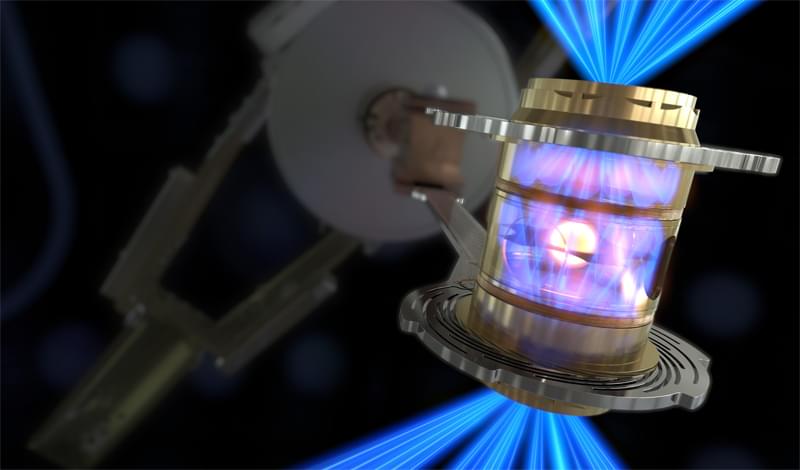
The U.S. Department of Energy (DOE) has today confirmed the achievement of “fusion ignition” at Lawrence Livermore National Laboratory (LLNL) – a major scientific breakthrough, many decades in the making, which could pave the way to near-limitless clean power.
On 5th December, a team at LLNL’s National Ignition Facility (NIF) conducted the first controlled experiment in history to reach this milestone, also known as scientific energy breakeven, meaning it produced more energy from fusion than the laser energy used to drive it. This first-of-its-kind feat will provide invaluable insights into the fusion energy process, which scientists have been attempting to develop for nearly a century.
Inside the target chamber of LLNL’s National Ignition Facility, 192 laser beams delivered more than 2 million joules of ultraviolet energy to a tiny fuel pellet to create the fusion ignition. These lasers heated the capsule to 100,000,000°C – more than six times hotter than the Sun’s core, and compressed it to more than 100 billion times the pressure of Earth’s atmosphere. Under these unimaginable forces, the capsule would have imploded on itself, forcing its hydrogen atoms to fuse and release energy.
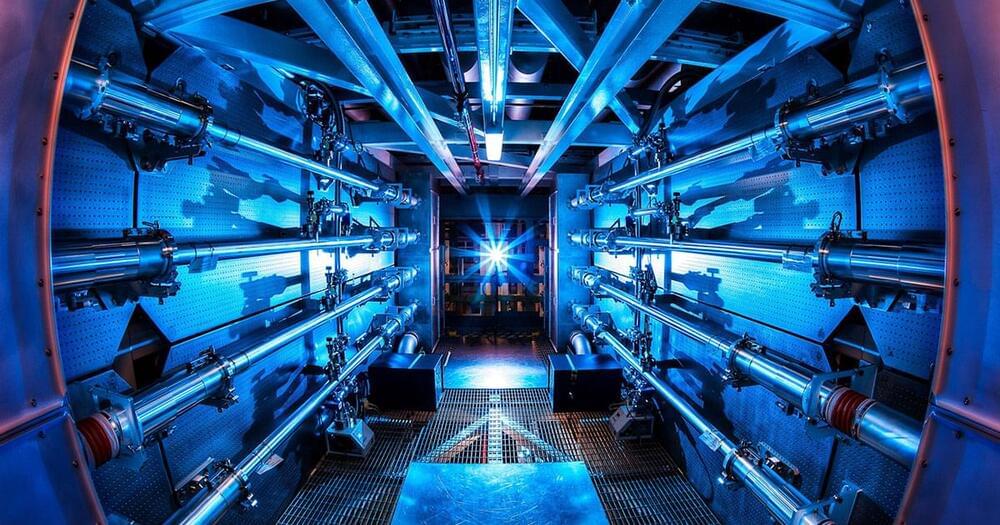
Researchers at the Lawrence Livermore National Laboratory claim to have achieved the seemingly impossible: generate more energy with a fusion reaction than they put into it, potentially paving the way for a truly environmentally friendly and safe source of power.
Their experiment, which involved using the “world’s largest and highest energy laser system” at Livermore’s National Ignition Facility to blast light at small capsules of deuterium-tritium fuel, generated 20 percent more energy than the amount required to power the system.
Despite the modest energy output — the system generated enough power to boil around two to three kettles — the researchers are boldly predicting that it could represent a major turning point in the quest to turn fusion energy into a reality.